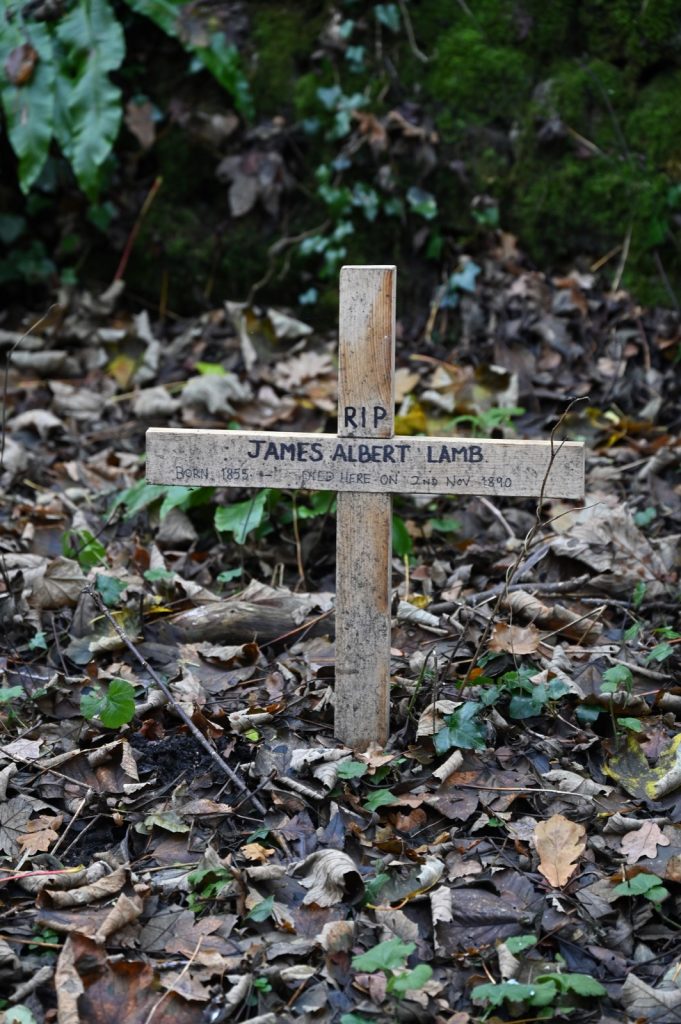
A simple wooden cross on the path leading to the old railway tunnel by the Nature Reserve marks the spot where James Lamb died in 1890. James was killed in an accident on the railway in November 1890.
Who was James Lamb? He was one of several children born in Great Tew in 1855 to George and Charlotte Lamb. Little is known about his childhood save that in 1871 he was an agricultural labourer living in South Newington with his parents and siblings. After marrying Sophia Shrimpton in 1877 they moved to Hooky and in due course he changed jobs and obtained work as a plate layer on the railway.
In late 1890 a landslip had occurred in the cutting between the station and the tunnel up by the Swerford road. A gang of men had been employed to clear the debris, however, work was only undertaken during daylight hours. After dark a man was stationed in the cutting at each end to watch for further landslides and to stop trains if necessary.
James was on duty on the evening of 1st November 1890. He duly set off from home in the village to undertake his duties passing the gang who had been clearing the cutting on their way home. As night watchman he was left to his own devices and it was not until later when a fellow workman went into the cutting to see if James had an adequate supply of oil for his lamp that he was found in a terrible state. Stephen Louch, also of Hooky, found James lying across the track suffering from injuries that had probably been inflicted by a passing train. After summoning help he was put into a pony cart and taken to the Horton Hospital in Banbury. Sadly his injuries were too severe for him to be saved and he died in the early hours of Sunday 2nd November.
An inquest was held at the Horton on Tuesday 4th November. His widow, Sophia, said that after being told about the accident she went to the scene and saw him lying near the line. “Both of his feet had been cut off and his brains protruding. He did not speak at all” she told the inquest. She had gone with him to Banbury in Mr Merry’s pony cart. No doctor had examined him prior to him being taken to hospital.
Several other employees gave evidence at the inquest including two train drivers whose trains passed along the track between the time James went on duty and when he was found. Both drivers had examined their trains after hearing of the accident and nothing was found that signified that either had struck him. The inquest heard that he should not have been where he was found. He should have been on the bank showing a green light walking up and down the cutting looking to see if a further landslip had occurred.
Stephen Louch said that James had no lamp with him when he was found. After a search it was found unlit in the manhole in the tunnel. His flags were also found some distance away. Mr Tayton, the coroner, remarked that if James had had his lamp still burning any train driver would probably have seen him and the accident perhaps would not have happened.
Other workers gave evidence and none had a bad word to say about James. He was regarded as a “steady man not given to drinking or subject to fits”.
The house surgeon at the Horton, Herbert Kershaw, told the inquest that he was on duty when James was brought in about 8.45pm on 1st November,. Both of his feet had been cut off and he had a wound about three inches long on his head. The head wound had smashed his skull leaving the brains protruding. Mr Kershaw said that James was insensible at the time and there was no chance of recovery. Death was due to the severe injuries he had received. In his opinion he felt that the head wound must have been caused by something striking him. It was a clean cut wound, similar to one which might have been inflicted by an axe.
So had James been murdered receiving the blow to the head first, falling onto the track and being run over by a train? Having studied several reports the family think so but have no proof.
Thanks to Paul and Helen Lamb for telling me they were responsible for placing the cross in summer 2021 which prompted me to write this. Paul is James’ great great grandson. Several local newspapers carried details of this gruesome tale including the Banbury Guardian of Thursday 6th November 1890.